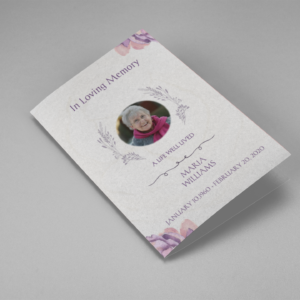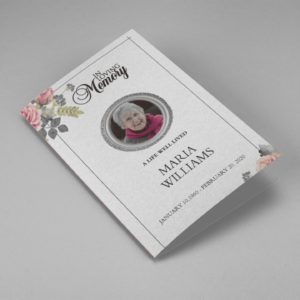In the digital age, more and more people are turning to online funeral programs to plan and organize memorial services for their loved ones. These programs offer a convenient and accessible way to create a meaningful tribute, and they can be a valuable resource during a difficult time.
Here is a guide to everything you need to know about online funeral programs:
What are Online Funeral Programs?
Online funeral programs are digital tools that allow you to create a personalized memorial service for your loved one. These programs can be accessed from any device with an internet connection, and they typically offer a range of features and customization options.
Benefits of Online Funeral Programs
There are many benefits to using online funeral programs, including:
- Convenience: Online funeral programs can be accessed from anywhere, at any time, making it easier for family members and friends to participate in the planning process.
- Cost-effective: Online funeral programs can be more affordable than traditional funeral services, which can be a significant consideration for families on a budget.
- Personalization: Online funeral programs allow you to customize every aspect of the service, from the music and readings to the visuals and decorations.
- Collaboration: Online funeral programs can be shared with others, allowing family members and friends to contribute to the planning process.
-
Searching for an Elegant Beige Funeral Program Template that is easy to print and has a cutting-edge look? Elegant Beige Funeral Program Template is the Perfect decision because is has a measure of 8.5”x 11”.
- No Limitation on Content, Edit anything
- Edit anytime – unlimited revisions even after purchased
- Get a printable PDF downloaded to get it printed on your own
-
Searching for a Grey and Burgundy Elegant Funeral Program Template that is easy to print and has a cutting-edge look? Grey and Burgundy Elegant Funeral Program Template is the Perfect decision because is has a measure of 8.5”x 11”.
- No Limitation on Content, Edit anything
- Edit anytime – unlimited revisions even after purchased
- Get a printable PDF downloaded to get it printed on your own
Features of Online Funeral Programs
The features of online funeral programs can vary depending on the provider, but some common features include:
- Templates: Many online funeral programs offer pre-designed templates that you can customize with your own text, photos, and other elements.
- Music and Readings: Online funeral programs often include a selection of music and readings that you can use in the service.
- Virtual Memorial Walls: Some online funeral programs offer virtual memorial walls, where family members and friends can share photos, memories, and messages.
- Live Streaming: Many online funeral programs offer live streaming options, allowing family members and friends who cannot attend the service in person to participate remotely.
How to Use Online Funeral Programs
Using online funeral programs is easy, and most programs offer step-by-step instructions to guide you through the process. Here are some basic steps to get started:
- Choose a Provider: Research different online funeral program providers to find the one that best meets your needs.
- Create an Account: Once you have chosen a provider, create an account and sign in to start designing your program.
- Customize Your Program: Use the templates and customization tools to create a personalized program that reflects the personality and interests of your loved one.
- Share Your Program: Share your program with family members and friends, and invite them to contribute to the planning process.
- Host Your Service: Whether you choose to host an in-person or virtual service, use your online funeral program as a guide to create a meaningful and memorable tribute to your loved one.
Contents of Funeral Programs
A funeral program, also known as a memorial program or order of service, is a printed document that outlines the details of a memorial service or funeral. The contents of a funeral program can vary depending on the preferences of the family, but here are some common elements:
- Cover: The cover of the funeral program usually includes a photo of the deceased, along with their name, birth and death dates, and any other relevant details.
- Opening Pages: The opening pages of the program often include a welcome message or introduction, along with information about the order of the service.
- Order of Service: The order of service section outlines the schedule of events for the memorial service. This typically includes music selections, prayers, readings, speeches, and any other activities planned for the service.
- Obituary: An obituary provides a brief biography of the deceased, highlighting their life accomplishments and contributions. It may also include information about their family members, interests, and hobbies.
- Poems and Readings: Poems and readings are often included in the funeral program, providing an opportunity for family members and friends to share their thoughts and feelings about the deceased.
- Photos: Funeral programs may include photos of the deceased, along with family members and friends, to help remember and celebrate their life.
- Funeral Home and Cemetery Information: Funeral programs may include information about the funeral home and cemetery where the service will take place, along with any other logistical details.
- Acknowledgments: The acknowledgments section of the program provides an opportunity for the family to thank those who have provided support and comfort during this difficult time.
- Closing Pages: The closing pages of the program may include a final message, prayer, or poem, as well as information about any post-funeral events or gatherings.
Online Funeral Programs Templates
-
Searching for a White Roses And Black Ribbon Funeral Program Template that is easy to print and has a cutting-edge look? White Roses And Black Ribbon Funeral Program Template is the Perfect decision because it measures 8.5”x 11”.
- No Limitation on Content, Edit anything
- Edit anytime – unlimited revisions even after purchased
- Get a printable PDF downloaded to get it printed on your own
-
Searching for a Realistic Burning Candle Funeral Program Template that is easy to print and has a cutting-edge look? Realistic Burning Candle Funeral Program Template is the Perfect decision because it measures 8.5”x 11”.
- No Limitation on Content, Edit anything
- Edit anytime – unlimited revisions even after purchased
- Get a printable PDF downloaded to get it printed on your own
-
Searching for a Bulltongue Arrowhead Funeral Program Template that is easy to print and has a cutting-edge look? Bulltongue Arrowhead Funeral Program Template is the Perfect decision because it measures 8.5”x 11”.
- No Limitation on Content, Edit anything
- Edit anytime – unlimited revisions even after purchased
- Get a printable PDF downloaded to get it printed on your own
-
Searching for a Grey Floral White Tiny Flower Funeral Program Template that is easy to print and has a cutting-edge look? Grey Floral White Tiny Flower Funeral Program Template is the Perfect decision because it measures 8.5”x 11”.
- No Limitation on Content, Edit anything
- Edit anytime – unlimited revisions even after purchased
- Get a printable PDF downloaded to get it printed on your own
-
Searching for a Red Flower Dark Soil Funeral Program Template that is easy to print and has a cutting-edge look? Red Flower Dark Soil Funeral Program Template is the Perfect decision because it measures 8.5”x 11”.
- No Limitation on Content, Edit anything
- Edit anytime – unlimited revisions even after purchased
- Get a printable PDF downloaded to get it printed on your own
-
Searching for a Pink Rose Frame Floral Oval Badge Funeral Program Template that is easy to print and has a cutting-edge look? Pink Rose Frame Floral Oval Badge Funeral Program Template is the Perfect decision because it measures 8.5”x 11”.
- No Limitation on Content, Edit anything
- Edit anytime – unlimited revisions even after purchased
- Get a printable PDF downloaded to get it printed on your own
-
Searching for a Brown and White Classic Funeral Program Template that is easy to print and has a cutting-edge look? Brown and White Classic Funeral Program Template is the Perfect decision because it measures 8.5”x 11”.
- No Limitation on Content, Edit anything
- Edit anytime – unlimited revisions even after purchased
- Get a printable PDF downloaded to get it printed on your own
-
Searching for a Purple Elegant Watercolor Funeral Program Template that is easy to print and has a cutting-edge look? Purple Elegant Watercolor Funeral Program Template is the Perfect decision because it measures 8.5”x 11”.
- No Limitation on Content, Edit anything
- Edit anytime – unlimited revisions even after purchased
- Get a printable PDF downloaded to get it printed on your own
-
Searching for a Cream and Green Photo Obituary Program that is easy to print and has a cutting-edge look? Cream and Green Photo Obituary Program is the Perfect decision because it measures 8.5”x 11”.
- No Limitation on Content, Edit anything
- Edit anytime – unlimited revisions even after purchased
- Get a printable PDF downloaded to get it printed on your own
-
Searching for a Cream Simple Elegant Photo Church Program that is easy to print and has a cutting-edge look? Cream Simple Elegant Photo Church Program is the Perfect decision because it measures 8.5”x 11”.
- No Limitation on Content, Edit anything
- Edit anytime – unlimited revisions even after purchased
- Get a printable PDF downloaded to get it printed on your own
-
Searching for a Grey Classic Minimalist Funeral Program Template that is easy to print and has a cutting-edge look? Grey Classic Minimalist Funeral Program Template is the Perfect decision because it measures 8.5”x 11”.
- No Limitation on Content, Edit anything
- Edit anytime – unlimited revisions even after purchased
- Get a printable PDF downloaded to get it printed on your own
-
Searching for a White Classic Funeral Program Template that is easy to print and has a cutting-edge look? White Classic Funeral Program Template is the Perfect decision because it measures 8.5”x 11”.
- No Limitation on Content, Edit anything
- Edit anytime – unlimited revisions even after purchased
- Get a printable PDF downloaded to get it printed on your own
-
Searching for a Cream Gold Marble Funeral Program Template that is easy to print and has a cutting-edge look? Cream Gold Marble Funeral Program Template is the Perfect decision because it measures 8.5”x 11”.
- No Limitation on Content, Edit anything
- Edit anytime – unlimited revisions even after purchased
- Get a printable PDF downloaded to get it printed on your own
-
Searching for an Elegant Beige Funeral Program Template that is easy to print and has a cutting-edge look? Elegant Beige Funeral Program Template is the Perfect decision because is has a measure of 8.5”x 11”.
- No Limitation on Content, Edit anything
- Edit anytime – unlimited revisions even after purchased
- Get a printable PDF downloaded to get it printed on your own
-
Searching for a White Floral Pro Funeral Program Template that is easy to print and has a cutting-edge look? White Floral Pro Funeral Program Template is the Perfect decision because is has a measure of 8.5”x 11”.
- No Limitation on Content, Edit anything
- Edit anytime – unlimited revisions even after purchased
- Get a printable PDF downloaded to get it printed on your own
-
Searching for a Grey and Burgundy Elegant Funeral Program Template that is easy to print and has a cutting-edge look? Grey and Burgundy Elegant Funeral Program Template is the Perfect decision because is has a measure of 8.5”x 11”.
- No Limitation on Content, Edit anything
- Edit anytime – unlimited revisions even after purchased
- Get a printable PDF downloaded to get it printed on your own
-
Searching for a Creative Watercolor Floral Funeral Program Template that is easy to print and has a cutting-edge look? Creative Watercolor Floral Funeral Program Template is the Perfect decision because is has a measure of 8.5”x 11”.
- No Limitation on Content, Edit anything
- Edit anytime – unlimited revisions even after purchased
- Get a printable PDF downloaded to get it printed on your own
-
Searching for a Soft Green and Grey Minimalist Floral Funeral Program Template that is easy to print and has a cutting-edge look?Soft Green and Grey Minimalist Floral Funeral Program Template is the Perfect decision because is has a measure of 8.5”x 11”.
- No Limitation on Content, Edit anything
- Edit anytime – unlimited revisions even after purchased
- Get a printable PDF downloaded to get it printed on your own
-
Searching for a Green Natural Funeral Program Template that is easy to print and has a cutting-edge look? Green Natural Funeral Program Template is the Perfect decision because is has a measure of 8.5”x 11”.
- No Limitation on Content, Edit anything
- Edit anytime – unlimited revisions even after purchased
- Get a printable PDF downloaded to get it printed on your own
Contents of a funeral program
A funeral program has a number of purposes. Aside from guiding families through the service, it may also serve as a lasting memento of the deceased. The contents of the funeral program may include the obituary and other personal information. The program may also feature a photo of the deceased. This way, the funeral program will always be a reminder of the life and love of the deceased. It is also a good opportunity to share a favorite memory or story.
When planning the funeral program, keep in mind the size and style of the program. The funeral program can be a trifold, gatefold, or graduated fold. Some programs may be tabloid or letter sized, with larger sizes costing more to print. Funeral programs can also be in a variety of colors and styles. In addition to choosing a format, you should also consider the number of photos and text to be included.
Cost of printing a funeral program
The cost of printing a funeral program varies widely. Some funeral programs are free while others cost anywhere from $25 to $150. You may want to shop around for the best price and explore the various paper options. If you decide to print your own funeral program, you may be surprised to learn that there are several ways to save money. Online tools make the process simple. Here are some tips to consider:
First, decide on the type of funeral program that you want. You may want to have the program printed on card stock paper. This paper should be at least 50 lb. Printed funeral programs may contain photos and written tributes. Most people hold the funeral program as a keepsake after the service. If you’re not sure about the quality of the paper used, consider using an online printing company. Many of them offer free shipping on orders over $50.
Examples of funeral programs
Funeral programs are typically printed with a variety of information. While they are not used to announcing the death, they do help people to remember the deceased. Some funeral programs have poems or quotes written for the occasion, while others include a scripture passage and the funeral service order. In addition to a variety of information, funeral programs may include an obituary. Listed below are some examples of funeral programs and what to include in them.
Choosing the right funeral program template is important. You’ll want something that reflects the elegy and dignity of the deceased. You’ll also want to include the names of family and friends, as well as the community in which the deceased resided. A funeral program will also serve as a memento and source of comfort for the family for years to come. So, be sure to choose a template that matches your needs and tastes.
Creating a funeral program with a template
A funeral program is a traditional item that includes the order of service, the list of events, poems or scriptures, photos, acknowledgments, and basic information about the deceased. You can customize it with the template provided by a graphic artist or by using any Word program. Then you can print it at home. A funeral program is a valuable item to keep, so it should reflect the deceased’s personality and interests.
A funeral program is typically comprised of three sections: service order, burial information, and the photo of the deceased. It may also include a eulogy or the funeral service schedule. It is important to note that these sections are not mandatory; however, they can be included. While the funeral program should reflect the deceased’s personality and uniqueness, it is not a requirement to include every detail of their life.
FAQ on Funeral Programs
Funeral programs are an important part of a funeral service as they serve as a tribute to the deceased and provide information about the order of service. Some common questions that may arise when preparing a funeral program include:
What should be included in the program?
The program should typically include the name, photo, and dates of birth and death of the deceased. It should also include an order of service, any readings or hymns, and information about the funeral service location, date, and time.
Who should be listed as survivors?
The survivors listed in the program will depend on the family’s wishes. Typically, immediate family members such as spouses, children, and parents are listed, as well as any siblings, grandparents, and close friends who played an important role in the deceased’s life.
What is the order of service?
The order of service can vary depending on the family’s cultural or religious traditions, as well as personal preferences. It may include elements such as a welcome, prayer or reading, music, eulogies, and a closing prayer or benediction.
What photos should be included?
Choose photos that capture the essence of the deceased’s life and personality. These may include childhood photos, photos with family and friends, and photos of the deceased engaged in their hobbies or passions.
Should religious or spiritual elements be included?
This will depend on the family’s wishes and beliefs. If the deceased had a specific religious affiliation, it may be appropriate to include elements such as prayers, hymns, or religious readings. If the family is non-religious, they may choose to include more secular elements.





















Leave a Reply
You must be logged in to post a comment.